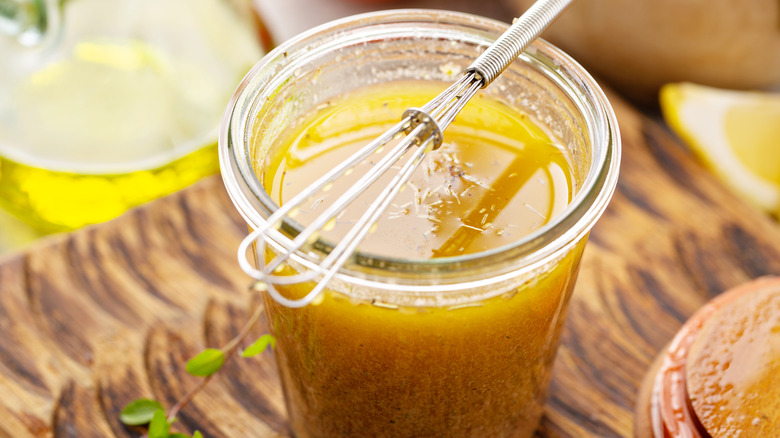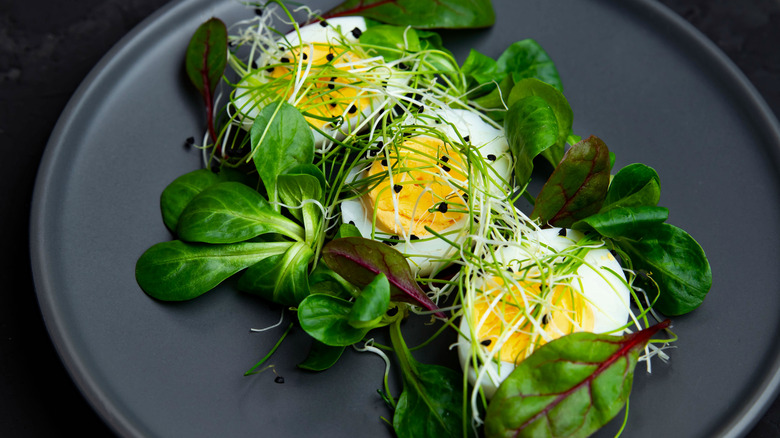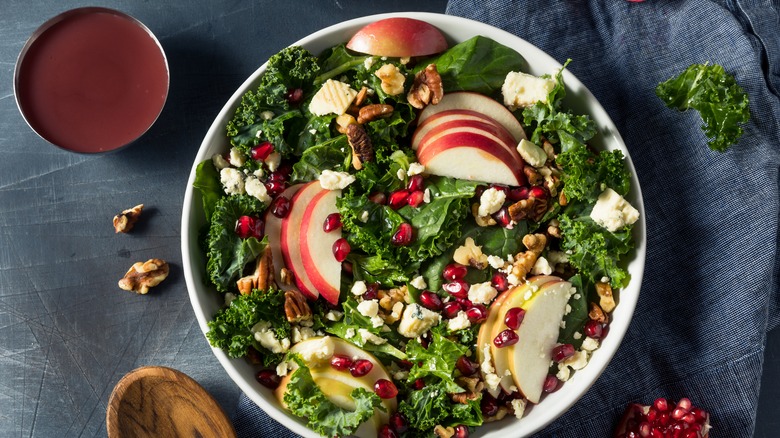Elevate Your Salad Game By Swapping Vinaigrette Flavors With The Seasons
Vinaigrettes are simple, versatile, and easy to make. They'll save you time and money, too — make a big batch and keep it in the fridge, and you'll always have a healthy and delicious dip, dressing, marinade, or sauce base. MasterClass explains that a traditional vinaigrette uses a ratio of three parts oil to one part vinegar, but within that combination, endless variations are possible. Some of these are regional. MasterClass adds that Italian vinaigrettes use olive oil and balsamic vinegar, and French preparations call for red wine vinegar and neutral-tasting oils, like grapeseed.
But your homemade vinaigrette can also reflect what you've got on hand — they're ideal for using up that last little bit of mustard or pickle juice, and a fun kitchen-helper project for a kid to make in a Mason jar. Got a lingering half a lemon, a trickle of Worcestershire sauce, a dollop of anchovy paste, and some not-so-fresh garlic? Put them in a vinaigrette! Another fun way to plan your vinaigrettes is around the time of year, and what's available in terms of seasonal food. By changing the flavor of your vinaigrette, you can effectively make different versions for every season.
Spring and summer vinaigrettes
Go light with your vinaigrettes in the spring. Use white balsamic, seasoned rice, champagne, or a fancy French wine vinegar like Julia Child did. A fresh, grassy extra virgin olive oil is the perfect fat element, but mild grapeseed or safflower oil or even a rich avocado oil will get you in the mood for green and growing things. Include chopped fresh herbs like dill, basil, and thyme to delicately dress your young shoots, baby spring mix, leaf lettuce, microgreens, sprouts, garlic scapes, edible blossoms, new veggies, and meat dishes like grilled chicken with basil mint vinaigrette.
In the summertime, take advantage of plentiful produce. Play with sweet, sunny flavors like sherry vinegar, berry-infused vinegar, and lemon or lime zest. Sunflowers are in full swing, so why not use organic, expeller-pressed sunflower oil for your fat? Refined coconut oil has a liquid consistency and a user-friendly taste. For spices, tomato powder captures the taste of the season — while smoked paprika and smoked salt bring barbecue flavors full circle. Serve your vinaigrette with summery salads or as a board sauce for grilled meats.
Fall and winter vinaigrettes
In the fall, it's all about celebrating the bounty of the season. Pair apple cider vinegar or malt vinegar with rich, nutty toasted sesame oil, hemp oil, hazelnut oil, or walnut oil and drizzle them on roasted autumn harvest salad or autumn pear salad, and crunchy plates of cabbage, kale, brussels sprouts, and squash. Sweeten the deal with honey or maple syrup, and round it out with Dijon mustard — a classic component used by everyone from Food Network to Martha Stewart. Don't forget timely toppings like dried cranberries and pumpkin seeds!
Cold weather calls for comfort foods, so a musty, mature balsamic or red wine vinegar is perfect for winter vinaigrettes. Use hearty oils for richness and weight — extra virgin olive oil, avocado oil, and nut oils fit the bill, but sometimes you need a little pep to cut through the wintertime dreariness. Using the leftover oil from a jar of Greek olives or cheese-stuffed cherry peppers will add a welcome flavor dimension, while citrus from the warmer climes will brighten baked salads, robust steakhouse wedge salad, and even meat and fish dishes — like Alaska salmon and lacinato kale with apple bacon vinaigrette or pork adobo wrap with pineapple vinaigrette, apple cider, and rum. With so much variety, the only limit is your imagination — you can make a vinaigrette for any occasion.


